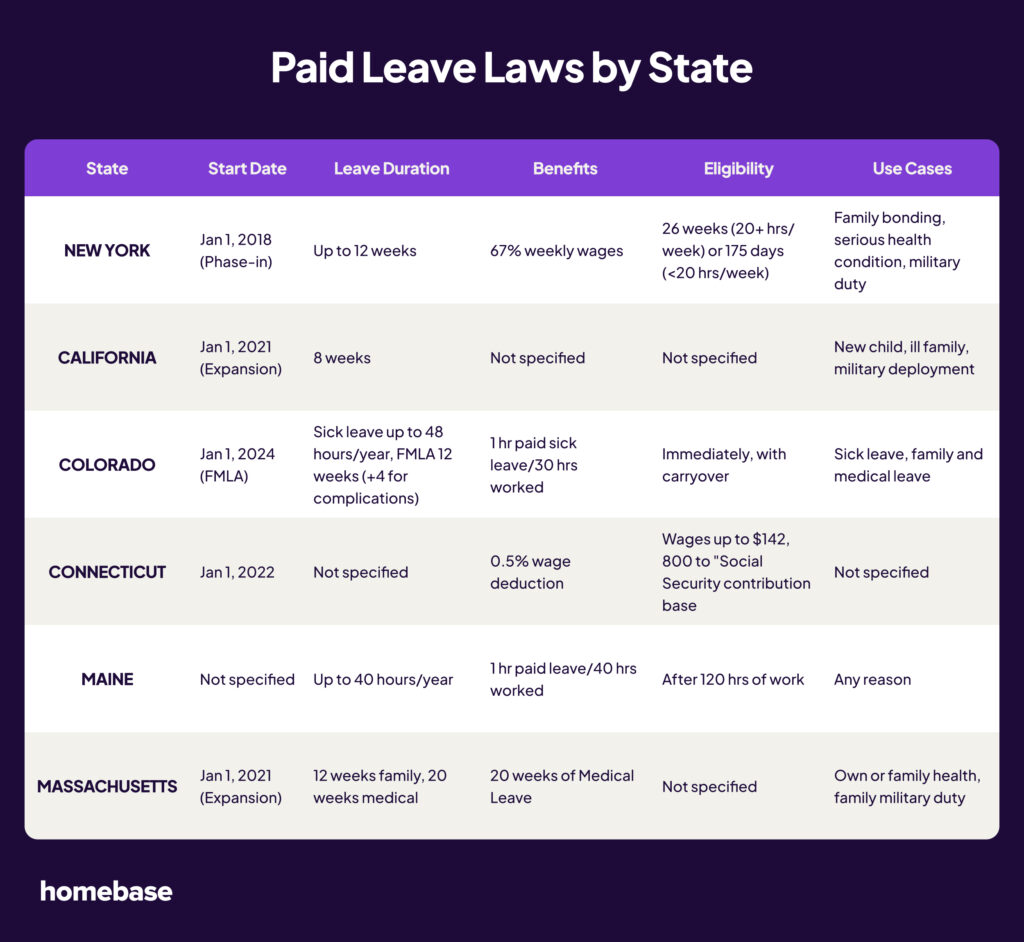The US Family and Medical Leave Act is a federal law that requires employers to provide unpaid family and medical leave to eligible employees. There are currently no paid leave laws stipulated by the federal government, but many state paid leave laws are in place in states across the country. And the 2021 state paid leave laws included new legislation, as well as increases to existing laws covering things like maternity, family, and sick leave.
Below is a list of states that are increasing paid leave benefits or establishing new leave programs.
If you’d like to see which states enacted paid family leave benefits in the 2020 calendar year, check out our article here. You can also view our state labor law guide center to learn about the leave laws in your area, as well as other employment legislation such as minimum wage. Parental and maternity leave can affect the gender pay gap, so it’s important to read up.

State paid maternity leave and parental leave laws in 2021

New York paid leave laws
New York State started a four-year phase-in plan on January 1, 2018 for their NY Paid Family Leave benefit, according to the NY State Department of Financial Services.
On January 1, 2021, eligible employees may take 12 weeks of leave to:
- Bond with a new biological, adopted, or foster child (both maternity or paternity leave)
- Care for a family member with a serious health condition
- Assist loved ones if a military service member in the family goes on active duty
To be eligible for leave accrual, employees who work 20 hours or more per week must work for 26 weeks. If they work less than 20 hours per week, they must work for 175 days.
The paid family leave wage replacement benefit amount is also increasing in 2021. Employees will receive 67% of their weekly wages, according to the Workers Compensation Board. The maximum replacement benefit will be 67% of the state average weekly wage, which is $1,450.17.
New York employees will be entitled to benefits stipulated under the new State Sick Leave Law on January 1, 2021. However, it technically went into effect on September 30, 2020.
The paid sick leave law stipulates that employers with 100 employees or more to provide 56 hours of paid sick leave per year. Employers with less than 100 employees must provide 40 hours of paid sick leave.
If a business has less than 5 employees and a net income of more than $1 million in 2020, the employees must receive 40 hours of paid sick leave. Businesses who have less than 5 employees and had a net income of less than $1 million in 2020 are required to provide 40 hours of unpaid sick time.
California paid leave laws
California’s Paid Family and Medical Leave will expand January 1, 2021 to include a Military Assist claim. Currently, new parents can receive 8 weeks of paid family leave within a 12-month period to
- Bond with a new child
- Care for a seriously ill child, parent, parent-in-law, grandparent, grandchild, sibling, spouse, or registered domestic partner
With the addition of the Military Assist claim, employees can take use the paid leave if they need “to participate in a qualifying event because of the military deployment of their spouse, registered domestic partner, parent, or child to a foreign country,” according to the California Employment and Development Department.
Colorado paid leave laws
A recently signed law will require employers to provide at least 1 hour of paid sick leave for every 30 hours an employee works, adding up to 48 hours per year. Employees may use the leave as soon as they accrue hours. They can also carry over 48 hours per year, but employers do not have to allow employees to take more than 48 hours in one year.
Additionally, Proposition 118 was approved by voters, which will allow employees to take 12 weeks of paid family and medical leave (FMLA) beginning January 1, 2024. Employees with pregnancy or childbirth complications will be eligible for an additional 4 weeks. A payroll tax will fund the leave, which employers and employees will split 50/50. The premium pay will begin on January 1, 2023.
Note: Businesses with less than 10 employees will not have to pay the employer premium.
Connecticut paid leave laws
The Connecticut Paid Family and Medical Leave Act won’t take effect until January 1, 2022, but employers must start taking deductions from employees’ pay to fund the program on January 1, 2021.
The deduction rate is capped at .5%, and it applies to wages up to $142,800, or the Social Security contribution base.
Maine paid leave laws
The Maine Earned Paid Employee Leave Law requires private employers with at least 10 team members who work more than 120 hours in a year to allow employees to accrue 1 hour of paid leave for every 40 hours they work. The maximum paid leave they can accrue is 40 hours per year.
Employees can use the paid leave for any reason. They can begin using the leave after working for 120 hours.
Massachusetts paid leave laws
Benefits established by the Massachusetts Paid Family and Medical Leave go into effect on January 1, 2021. Employees will be able to take 12 weeks of paid family leave, and 20 weeks of paid medical leave for their own health conditions. The state administers the pay, but payroll deductions fund it.
Employees can use the leave to manage their own serious health condition, bond with a new child, care for a family member who is a member of the service, or manage family issues if a family member goes overseas on active duty.
Note: If an employee is caring for a service member in the family, they may take 26 weeks of leave.

